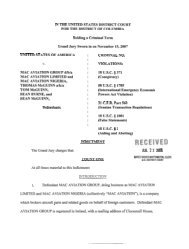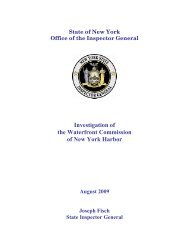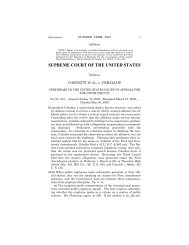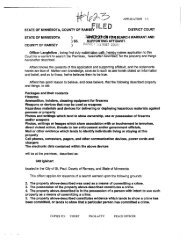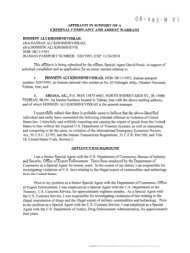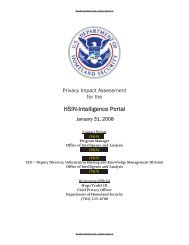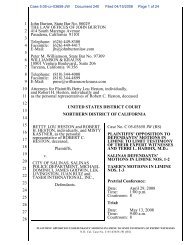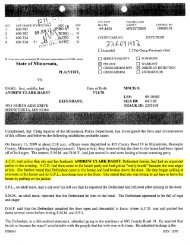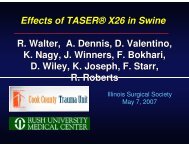TASER Electronic Control Devices Review Of Safety Literature
TASER Electronic Control Devices Review Of Safety Literature
TASER Electronic Control Devices Review Of Safety Literature
You also want an ePaper? Increase the reach of your titles
YUMPU automatically turns print PDFs into web optimized ePapers that Google loves.
For the risk of delivering a pulse into the vulnerable period of the cardiac cycle<br />
the charge required is about 100–130 times that which the <strong>TASER</strong> X26 delivers.<br />
The <strong>TASER</strong> M26 safety margin was calculated at an even higher range of 118-<br />
153:1.<br />
Concerning the risk for the delivery of “continuous” current there is a safety margin<br />
of 74:1-89:1 for the <strong>TASER</strong> X26 and <strong>TASER</strong> M26.<br />
These above analyses are based on currents applied down the trunk typically<br />
from a leg to an arm. Currents passing from arm to arm have considerably higher<br />
safety margins. With a barb tip close to touching the heart, the margins are lower<br />
as will be discussed later. In drive-stun mode the safety margin is significantly<br />
increased.<br />
2.4 Computer Modeling Results<br />
Extensive computer modeling has been performed to analyze the flow of the<br />
ECD current in the human body by Dorin Panescu, a recognized authority in finite<br />
element analysis of biological current flow. 43-45 The models calculated<br />
strength-duration thresholds for heart cell excitation and VF induction. Finite element<br />
modeling is used to compute current density in the heart for worst-case<br />
<strong>TASER</strong> electrode placement. The model predicts a maximum <strong>TASER</strong> current<br />
density of 0.27 mA/cm 2 in the heart. Numerically simulated <strong>TASER</strong> ECD current<br />
density in the heart is about 1/2 the threshold for cardiac myocyte excitation and<br />
more than 500 times lower than the threshold required for inducing VF. Thus<br />
<strong>TASER</strong> devices do not generate currents in the heart that are high enough to excite<br />
myocytes or trigger VF. Other modeling studies have been published as<br />
well. 46,47<br />
2.5 Animal Study Results<br />
Sensitive Swine<br />
Swine are more sensitive to electrical induction of arrhythmias than are other<br />
mammals. 39 In dogs and humans the Purkinje fibers (the “nerves” in the heart<br />
that carry the initial excitation signal) are confined to a very thin endocardial<br />
layer. 48 In pigs the fibers cross the entire ventricular wall. 40 Thus activation in<br />
swine proceeds from the epicardium to the endocardium while in dogs and human<br />
it proceeds in the reverse direction. 49 Thus, swine are much more sensitive<br />
to external electrical currents. Swine hearts are literally wired inside out compared<br />
to humans. For example, high frequency cardiac ablation is performed on<br />
hundreds of human patients every day without the induction of VF. However, the<br />
exact same procedure will typically lead to VF in a swine. 50<br />
Thus swine provide an extremely conservative test for cardiac safety of ECDs. If<br />
an ECD fails to induce VF in a swine with conditions similar to law enforcement<br />
or self-defense field usage, this implies a high degree of safety. If however, one<br />
32




